We are peaceful people, but our armored train ... Part of 1
You can not imagine the tank T-34, near which there will be no visitors. Or lonely "Katyusha". No, it can be, but in one case - if the museum is not really a museum, but so ... Place of development of funds and budget.
Thank God, in our country this phenomenon is very rare, and it is not about unfortunate museums now.
Today we will talk about armored trains. That is, in the plural. Although we will focus on the object that was already produced during the war - the BP-43 armored train, but we will not ignore as much as the other models.
The question arises: why in the plural? The answer is simple. Each armored train is unique. This applies to any such armored vehicle. There are no two identical trains.
Very often, when considering an armored train, a quite reasonable question arises: “Why didn’t much attention paid to such powerful weapons in the USSR?” For the answer (which will be more than surprising) it is necessary to return to the time of civil war.
Understanding the significance of armored trains came a long time. That is why the lack of such compositions in the Red Army was not. The exact number of armored trains at the time of the end of the Civil War could not be established. But the figure of BP, which were in the combat units of the Red Army, is - 123 units!
It should be noted that the concept of “armored train” itself is rather vague. In the orders of the time often there are heavy and light armored trains, armored platforms, breakthrough power supplies, armored cars and so on.
For an example it is worth telling about one legend. It is a legend. About the Green Ghost. For almost a hundred and fifty trips, the “Green Ghost”, as the Germans called him for elusiveness, destroyed about a dozen enemy tanks and armored cars, two and a half dozen machine gun nests and bunkers, six bunkers, three aircraft, one heavy artillery battery and up to one and a half thousand soldiers and officers of the enemy. In June 42, he even entered into battle with a column of German tanks and emerged victorious from him, destroying three cars.
In fact, the "Green Ghost", as the Germans called it, is BP No. 5, the armored train Zheleznyakov, the Coast Defense of the Black Sea Main Base fleet in the Sevastopol. And the "Ghost" was created on November 4, 1941 (officially) at the Sevastopol Marine Plant.
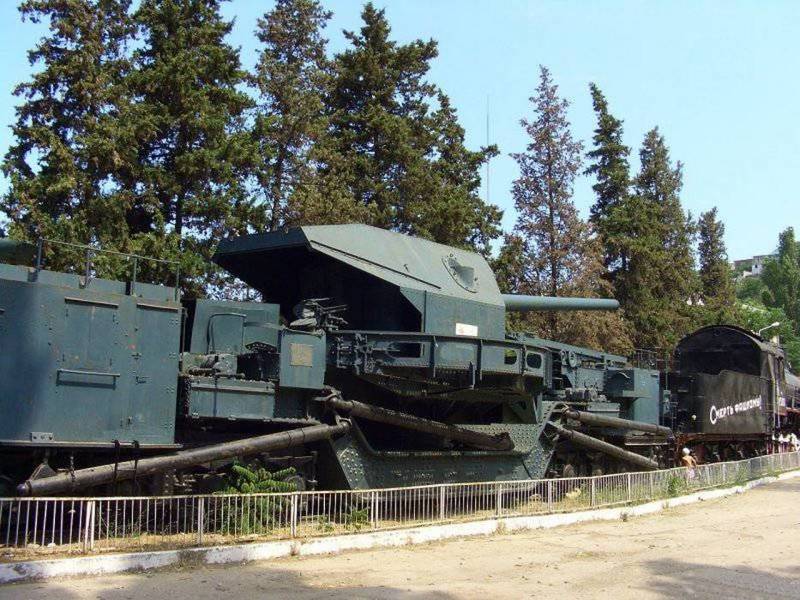
If you look at the composition of the BP, then except as a "hodgepodge", you can not call it. The armored train No.5 had five 100-mm guns, eight mortars and a half dozen machine guns. In addition, in addition to the main armored steam train as part of Zheleznyakova, there was an additional locomotive that significantly improved the driving characteristics. And both locomotive worked in battle.
Alas, in June 1942, the Green Ghost was blocked in one of the mountain tunnels and lost to the Red Army. The Germans destroyed the exits by air strikes and threw in an armored train. In August, the composition was excavated. He received the new name "Eugen" and served in the German army until May 1944. It was blown up by the Germans.
And what, ask, is the difference between a heavy and light armored train? And then for some reason, the smell of the sea and the sea classification. Take the cruiser. The main-caliber guns in the 203-mm made the cruiser heavy. 152-mm - easy.
The same was true for armored trains. The presence of a heavy cannon site in the BP automatically translated it into “heavy” ones. The presence of more conventional platforms with air defense systems (usually 4 and more) made the PSU object of air defense. And so on.
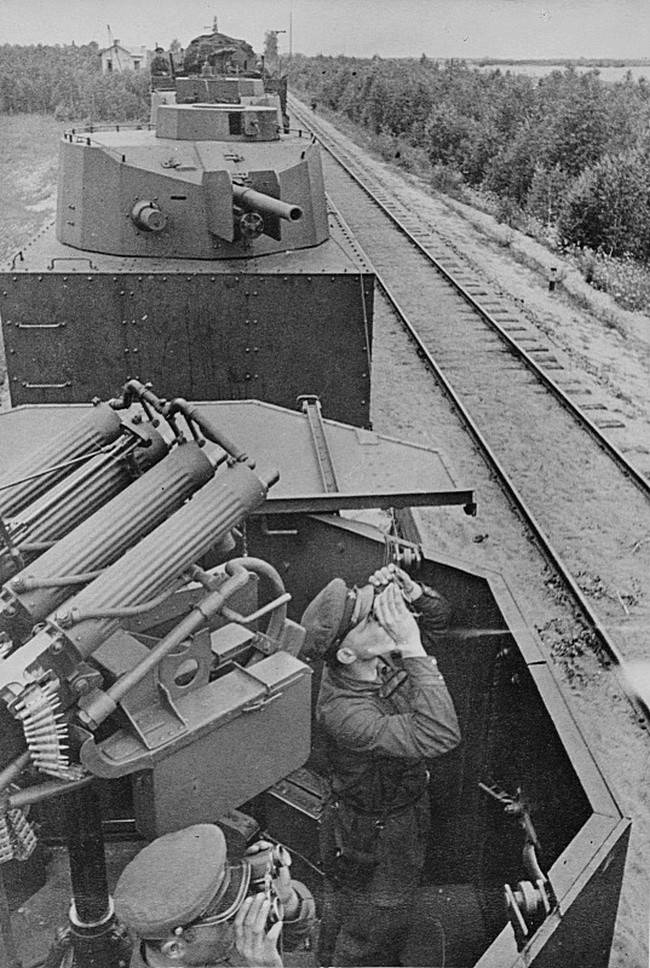
It is here that the BP is a train! Therefore, the composition can be formed from different cars and platforms. Depending on the tasks performed at a specific time. It is clear that the armored train that protects the station in the depths of the front from enemy raids aviation, no need for heavy weapons. Just as a breakout BP is simply obliged to increase its own firepower precisely for work on a ground enemy.
In addition to the Red Army, there were armored trains in parts of the NKVD. The first such train ("Felix Dzerzhinsky") was transferred to the NKVD in 1930 year. The task of these armored trains and were most often the task of protecting stations, objects of the structure of railways, patrolling of railways.
There is another nuance that you just need to tell. This is the composition of the train itself. Oddly enough, but most readers do not even have questions about basic things during the inspection of armored trains. It is elementary!
An armored train is a technically rather sophisticated type of weaponry, with a large crew and many components required to perform combat missions. For example, it is often the opinion that to destroy a BP, it is enough to bomb or undermine the paths ahead and (or) behind the train.
However, few people say that the train crew included not only transportation specialists who were able to repair destroyed roads in a short time, but also the materials necessary for this: rails, sleepers, crutches, and so on. Back in the days of the Civil War, a tactic was worked out to undermine the ways for stopping the BP. Well, and, accordingly, ways to deal with miners.
Why are there explosions. There are even simpler questions. The crew just has to eat! Moreover, every day and three times desirable. And who saw in the train kitchen? And the infirmary? And if the boilers on the armored steam engine are slagging somewhere far from the station?
What we often call the armored train is actually only a part of it! Fighting, but part! In fact, the armored train consists of a much larger number of components.
The classic scheme of an armored train looks like this:
1. Armored locomotive. What we used to call the armored steam train with an armored tender or armored tanker.
2. Unarmoured (black) locomotive. It is used as a backup and is not often involved in hostilities. With the redeployment of BP used as an additional locomotive. Located in the rear at the base station.
3. 2-4 armored car (armored platform) with artillery weapons (or, as in the case of the German BP, installed on the platform tanks).
4. 2-4 armored car (armored platform) with anti-aircraft weapons.
5. 2-4 control platforms. Another name is a cover platform. Used for the transport of materials for the repair of tracks.
6. Armored or armored (using sandbags to protect) platform or landing platform. This element is used as needed.
This is what we see in battle. Armament (armored cars and (or) armored platforms) is combined for various tasks. But there is more. What is in the rear. This is the base (official name) of an armored train.
Such a base, in fact, was another train. In motion in the rear, the base and base were one echelon. On the forward base remained at the nearest rear station.
As part of the base it was sometimes up to 20 and more cars. Starting from the kitchen and ammunition depots to the infirmary and weapon repair shops. In the event of a breakthrough of the enemy, the “black” locomotive was used as a locomotive to evacuate the base to a safe place.
But back to our heroes. 22 June 1941, the Red Army included 53 operating armored trains. As part of the NKVD - 23 BP. The figures are rather freely interpreted in various sources because of the very “blurring” of the BP concept.
Trains were actively used in the initial period of the war, 1941-1943 years. However, in subsequent years, their combat path continued.
The main task of the BP was to support rifle units operating in the railway line, defense or seizure of railway stations, protection from air raids, counter-battery struggle, and landing of assault forces to capture railway objects.
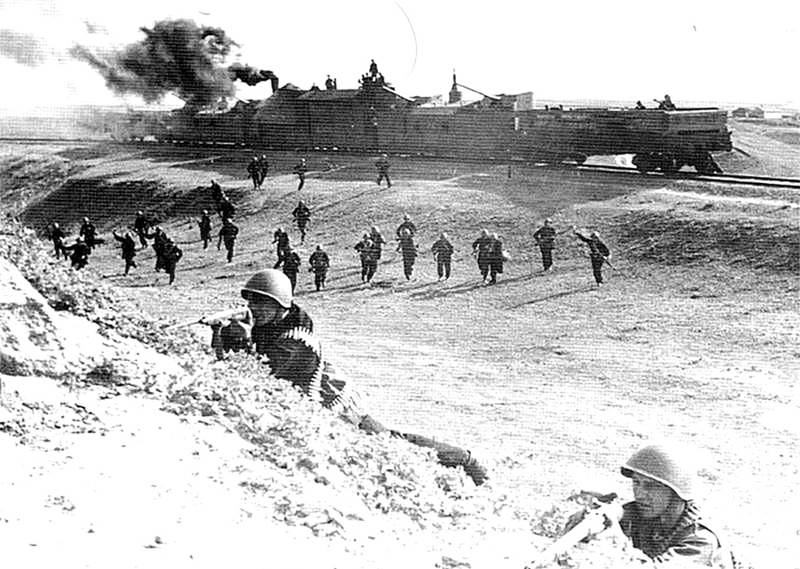
Today it sounds strange, but it was precisely in the first months of the war that the anti-aircraft armored trains proved to be very effective. Those trains that were equipped with armored cars (armored platforms) with 37 or 25-mm anti-aircraft guns and DShK anti-aircraft guns. By the way, the air defense system in the name of the train speaks not only about the composition of the BP’s weapons, but also about belonging to the air defense forces.
I would like to recall one document, which for some reason is not mentioned much today, but which shows the significance of the BP for the Red Army in the first months of the war. The People's Commissariat of Defense 29 of October 1941 of the year issued a directive numbered 022ss.
By the number you can see that the document is completely secret. In fact, this directive prescribed in a short time to create the 32 (!) Division of armored trains! True, in the division (in the new state) there were only two BP, but still, you see, the scale shows the values of this weapon.
By the way, we speak a lot of common phrases about the feat of the people in the rear. In the situation with the implementation of this directive feat resulted in the "extra" 20 armored trains! Instead of the planned 65 BP in the USSR released 85! And this is the end of 1942 year!
Undeservedly forgotten and exploits of the crews of armored trains. Meanwhile, 5 BP (2 as part of the Red Army and 3 as part of the NKVD) were awarded the Order of the Red Banner. Ten separate divisions of armored trains received honorary titles.
According to official figures, during the period of the Great Patriotic War, 370 tanks, 344 guns and mortars, 840 machine guns, 712 vehicles, 160 motorcycles and two armored trains were destroyed! And for German pilots, an armored train was generally an inconvenient goal - 115 downed aircraft!
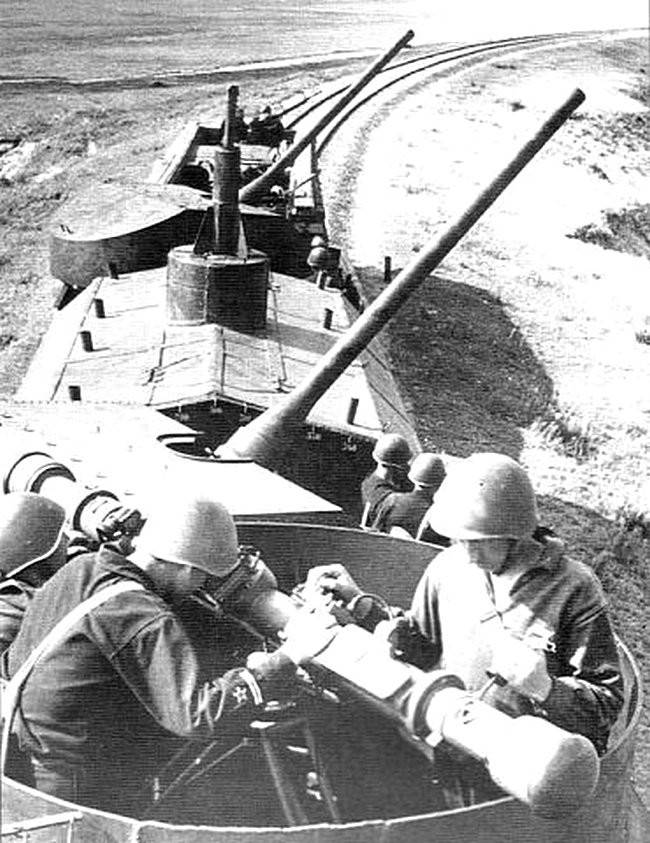
Not without loss. And the losses were huge. According to official data, during the period of the Patriotic War, we lost only in the Red Army 65 armored trains! Of these, 63 is in 1941-42's. In 1943, two trains were lost.
Probably worth telling about one episode of 1941 of the year. One of the many episodes, the story of which shows not only the heroism of Russian soldiers, but also the hardness and healthy "arrogance" of the red commanders.
In August 1941, the German landing force in Ukraine managed to seize the Zhuliany station. Unfortunately, at the station, among other goods, there were several cars in which equipment was available for the needs of the Red Army aviation. Engines and other spare parts for repair. By the time every working plane was worth its weight in gold - a very valuable cargo.
To protect themselves, the Germans at the entrance to the station dismantled the rails and blew up a small bridge. However, this did not stop the crew of the Liter A armored train. This armored train consisted of an armored steam locomotive (a typical armored steam locomotive of the OV series) and three armored platforms armed with 4 guns and 24 machine guns.
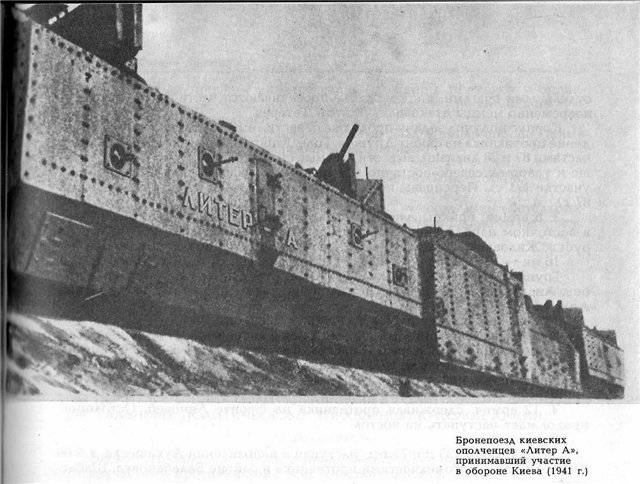
The commander of an armored train, A. S. Tikhokhod, at night sent a team of repairmen and a group of fighters to restore the railway track and bridge. After the railway and bridge were rebuilt, an armored train at full speed at 4 broke into the station at one o'clock in the morning and opened hurricane fire at the stunned enemy.
As a result of the actions of the armored train station was released from the German assault. More precisely, the Germans simply escaped in horror, unable to withstand the psychological burden. That, in fact, was part of the plan of the Soviet fighters and commanders. Taking advantage of the panic, the crew of the armored train hitched the wagons with valuable cargo and took them to Kiev.
It is logical to assume that the main losses of the Red Army had to be borne in 1941 year. However, in the case of BP this statistics does not work. In 1942, twice as many trains were lost as in 1941. 42 lost armored train for one year. And it says a lot.
1942 is considered the most difficult for the entire period of the war. The Germans had a total superiority in aircraft and tanks. And in these conditions, the commanders had no other options on how to use the armored train "in full". To simultaneously repel attacks on the ground and from the air.
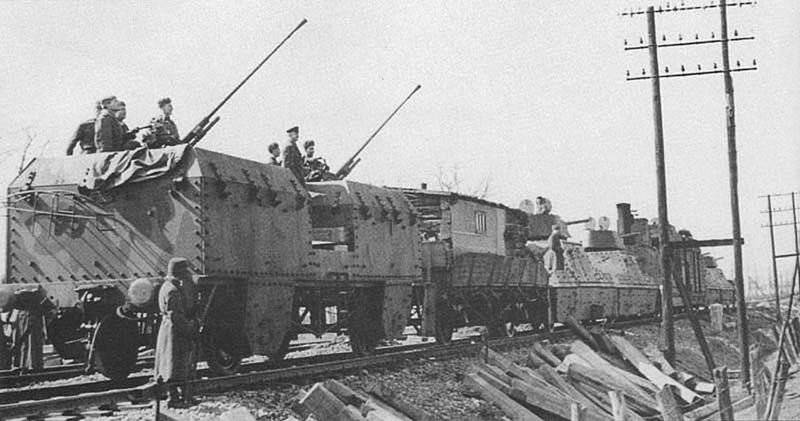
Sometimes it is necessary to explain the destructiveness of such tactics even for the most well-armed and autonomous object. It is impossible to simultaneously perform multiple maneuvers. Especially limited. Armored trains in the 1941-42 years were forced to act that way. Soviet kamikaze? No, the heroes who went to their death understood that perfectly.
Today, it is not clear to those who stand at the museum's armored train how this train could have been at the forefront. Especially if you have at least some understanding of the composition of the enemy, his weaponry, the general military situation of the time.
A huge goal that is difficult to disguise, not only from the enemy aircraft, but also from ground reconnaissance. The smoke of the locomotive is visible far enough. The offensive-retreat path is visible to anyone. From the railway this monster will not go anywhere. Armor? 20-mm for the guns of the second world war no armor ...
Powerful weapons? Already for the middle of the war it is difficult to call him powerful. Armored trains tank tanks a priori no more powerful than the same tank towers. And the artillery guns and mortars from the field units are even more powerful.
Even aviation, with the advent of more advanced sights and more powerful weapons, became disastrous for the BP. Hit bombs and aircraft guns have become quite frequent ...
And the crews of these trains not only fought and died. They won! About one victory, known and described by many authors is not a sin to remember today. About how Ilya Muromets of Adolf Hitler destroyed! it historical fact.
Epic names, is not it? So we liked it. In the office language, this phrase sounds different. The Soviet armored train Ilya Muromets destroyed the German armored train Adolf Hitler in a battle.
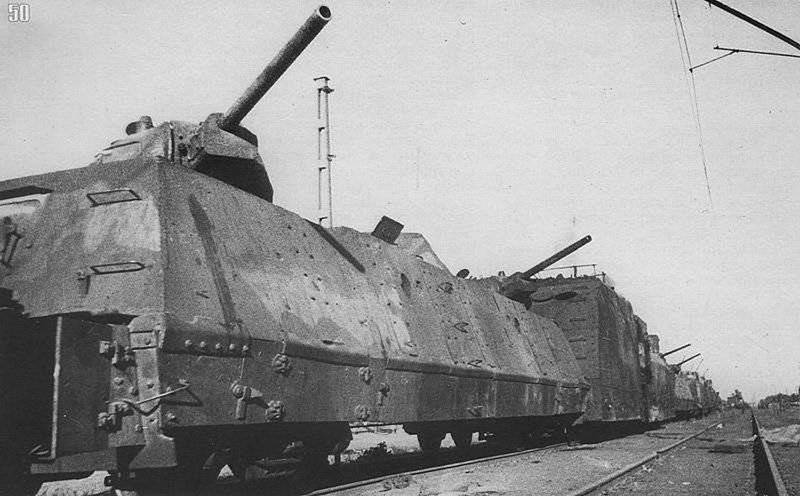
In the last days of May, 1944, the Soviet positions in the area of the Ukrainian city of Kovel were subjected to a three-minute artillery bombardment. Intelligence roughly calculated the location of the enemy's battery, after which a plane was sent to the area in order to clarify the location of the enemy's guns. The flight did not give any result - there was nothing in the specified area.
However, ground reconnaissance continued to search for the battery and the next day, on 9 in the morning, the scouts noticed the smoke of a locomotive. What allowed them to conclude about the actions of the enemy armored train. The information was delivered to the command. Destroy the armored train was assigned to the commander of the 31-th separate division of armored trains.
The headquarters of the 31 division developed an operation to destroy the "German". Directly duel had to lead a new armored train "Ilya of Murom".
Knowing the punctuality of the Germans, the Soviet commanders used it to improve their own position. The Germans not only started shooting at the same time, but they did not change the place for firing. Worked on the landmarks.
In the morning 8 "Murom" took up a position to attack. The German appeared a few minutes before 9. There was no direct visibility between the trains, which is quite remarkable. Both BP were in closed positions. Therefore, "Ilya of Murom" was guided by the enemy volley.
After the volley of a German armored train, Soviet gunners fired a volley already at an enemy BP. However, to destroy the first German volley failed. The second volley sounded almost in sync. The Germans managed to turn the towers in the direction of the Soviet armored train.
And then, approximately in 15 minutes after the start of the duel, “Muromets” showed its strength. The fact is that this armored train was armed with rocket launchers. Here "Katyushami" and trampled on the German "Muromets". The result of the attack is impressive. "Ilya Muromets" without hits and losses, the German, ironically, it turned out to be "Adolf Hitler", received such damage that it was decided not to restore it.
After a brief historical excursion, it is time to proceed to the description of specific armored trains. The lesson is not less interesting and informative than the historical excursion. So - to be continued.
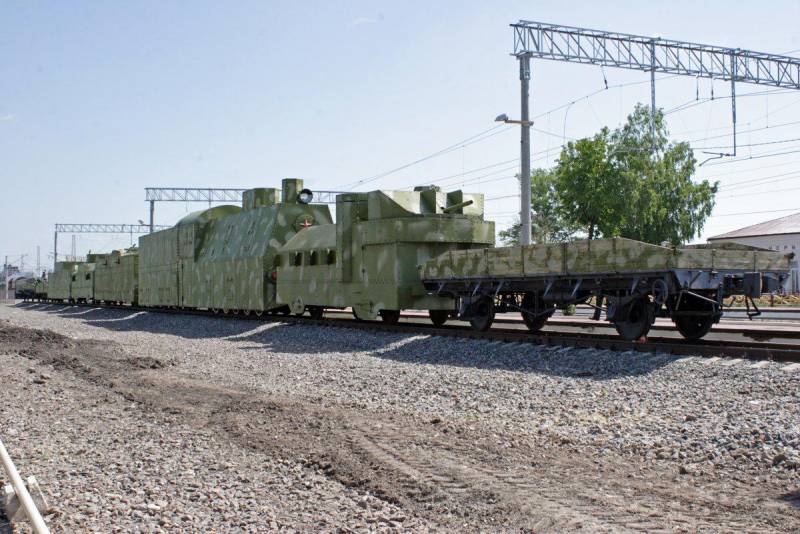
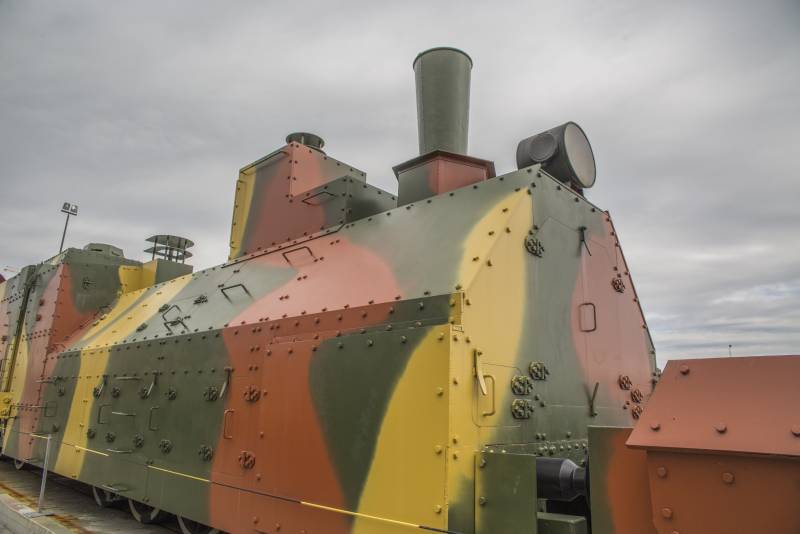
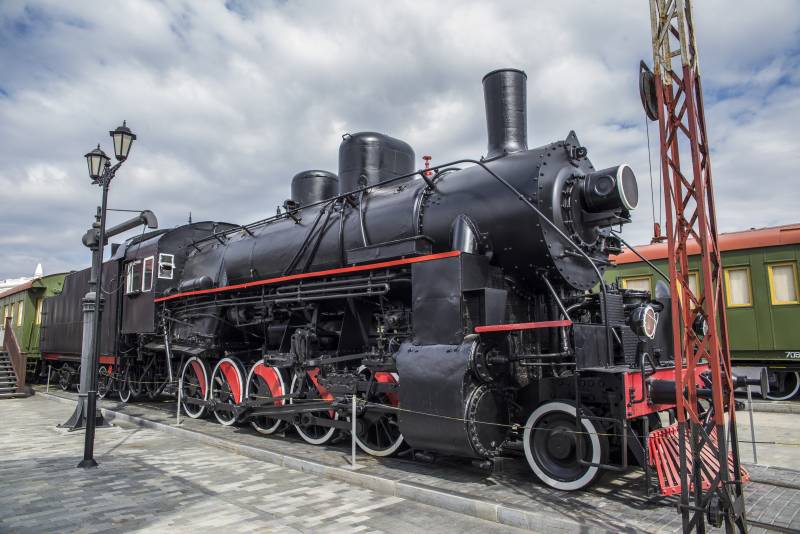
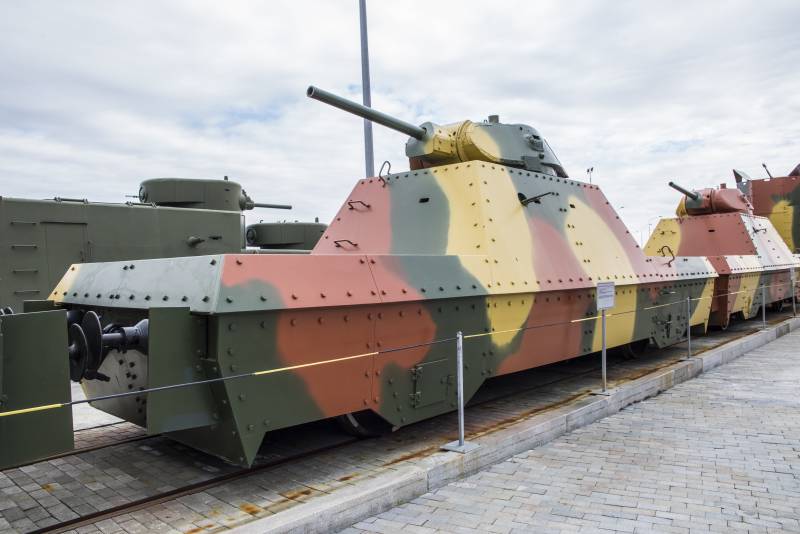
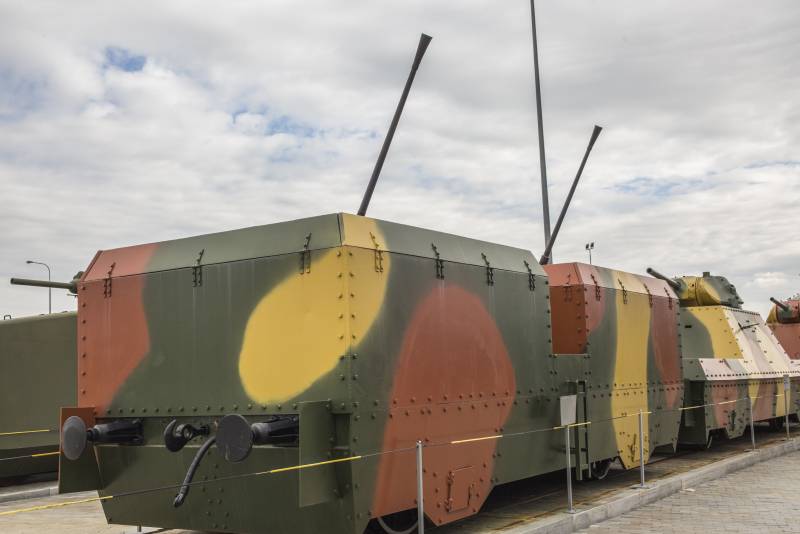
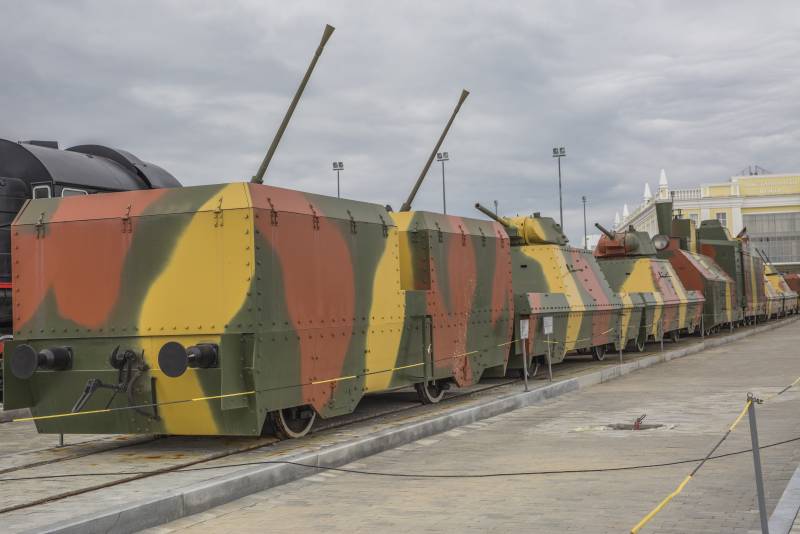
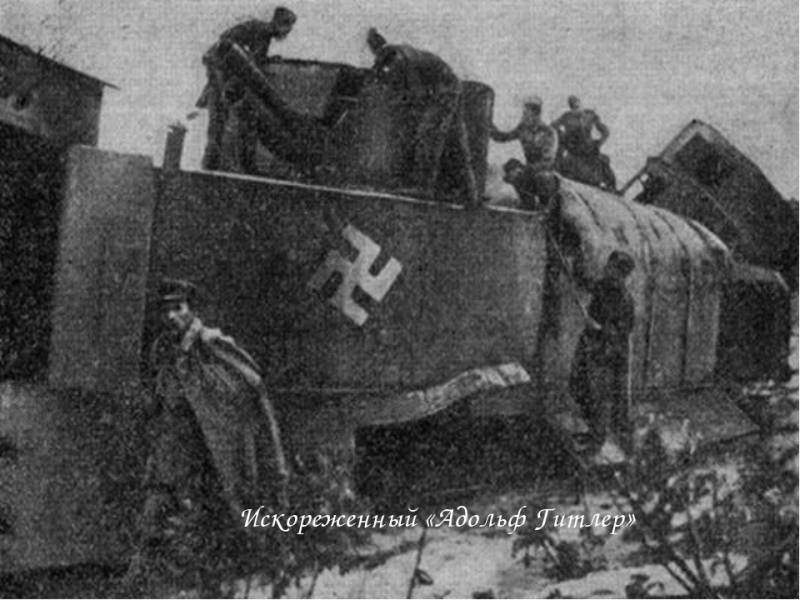
Information